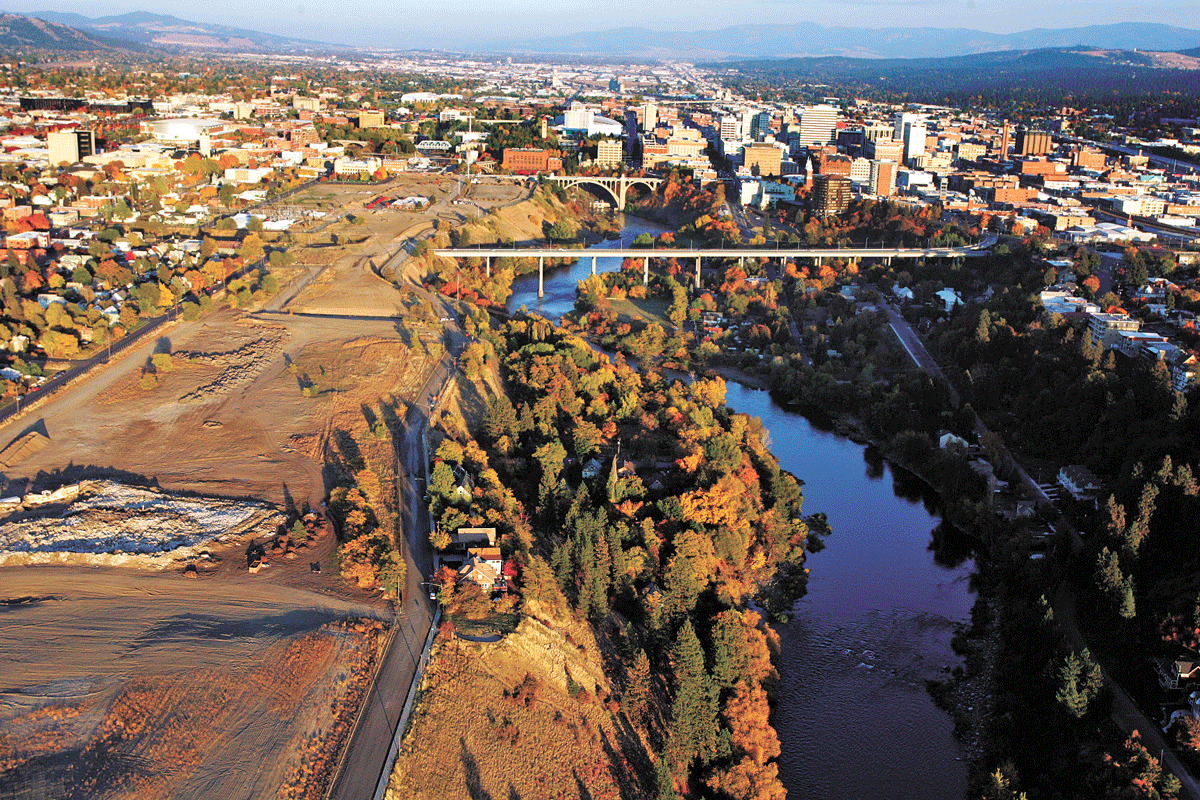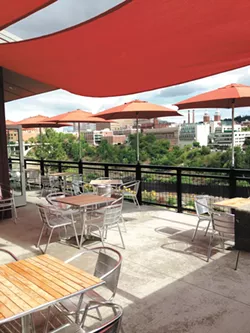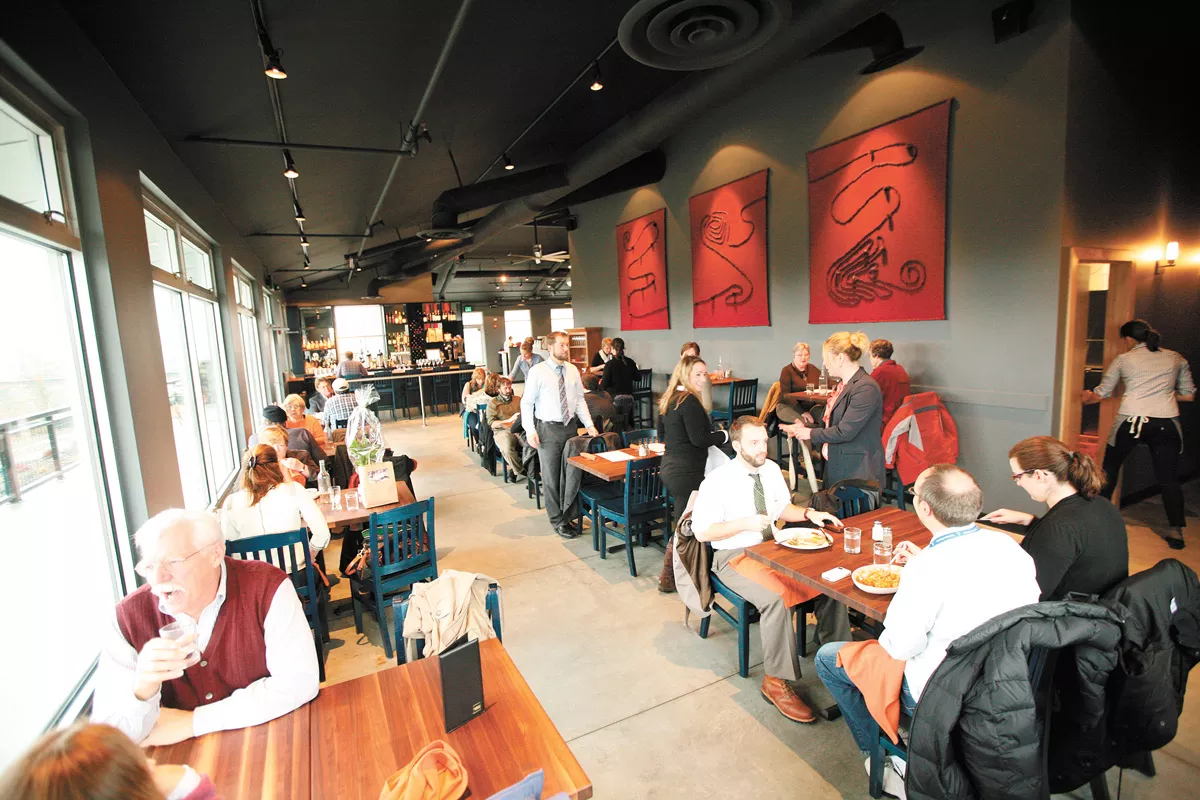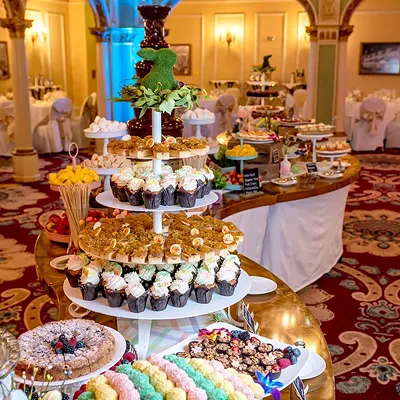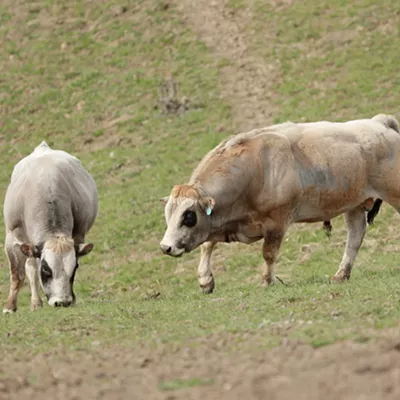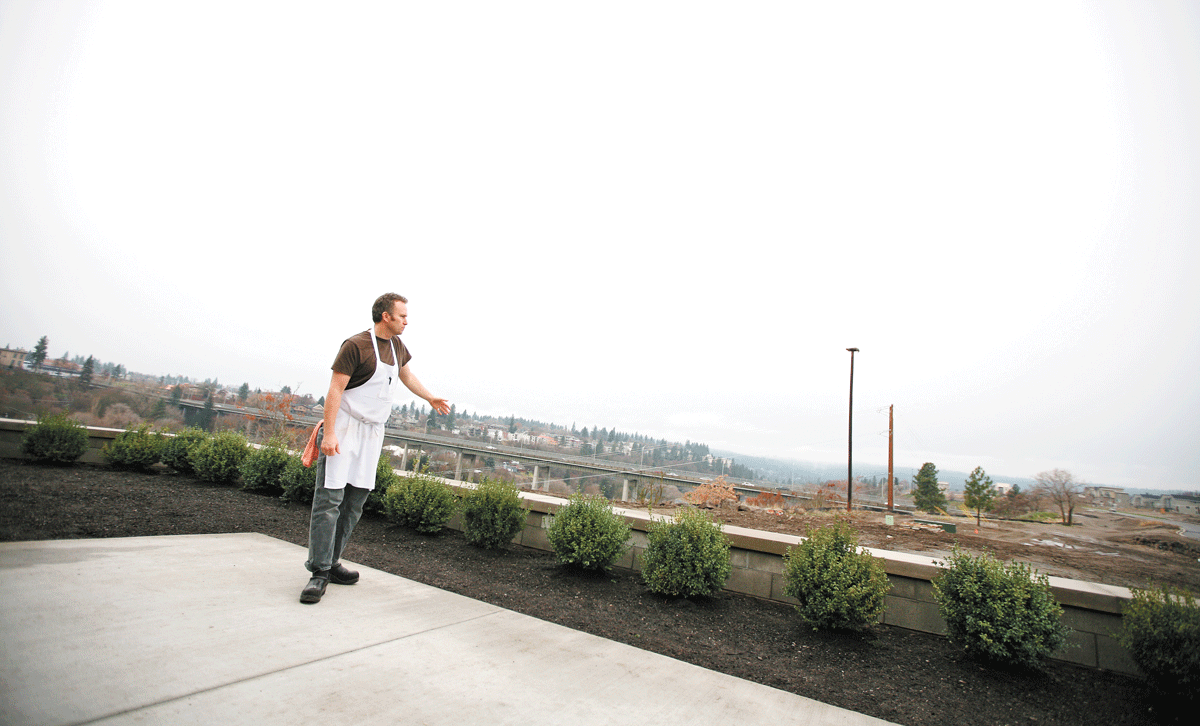
When I began thinking about the relationship between neighborhoods and food in Spokane, we were still in COVID lockdown and I hadn't been out to eat in over a year. A persistent memory of forever afternoon on Central Food's patio was driving me crazy and keeping me halfway sane: the toasted sourdough, the rhubarb jam, coffee in hand, brunch on the way, my family and I just sitting there, drenched in sun and cooled by the breeze off the Spokane River while people below strolled the Centennial Trail. I won't say I was sick of my own cooking (I was sick of my own cooking), but I was worried my favorite places were all going to go out of business. I'd begun to wonder if, once the pandemic was over, Olive Garden would slink through town, bodysnatch all the empty restaurant spaces, and breadstick Spokane's culinary culture back to the early '00s, when my husband was advised upon moving here that the best restaurant in town was Red Robin.
Chef-owner David Blaine temporarily closed Central Food in July 2020 due to the pandemic and permanently closed it by the end of that year. None of us will have coffee or jam or a Korean pork sandwich on that patio again. Of course, the Kendall Yards neighborhood is still there. The patio is still there. We will be able to enjoy a seat in the sun by the Spokane River when Molé Mexican opens there this summer. But before that happens, before we get back to normal, and before we forget that there was ever anything besides an excellent Mexican restaurant in that space, I want to remember what it was about Central Food that made that restaurant feel like Spokane's back porch.
Central Food anchored Kendall Yards when the neighborhood was still just a story that Greenstone Homes was telling about a derelict railyard. What role did it play that only a restaurant could play in making a former brownfield seem like a fine place to spend happy hour? And is there something particularly Spokane about the way Central Food helped establish Kendall Yards?
If you, like me, moved to Spokane after 2012, it's impossible to see and almost as hard to imagine that all the land from the Centennial Trail to Bridge Street was once a "post-apocalyptic hellscape," as Blaine calls it, remembering the "bunny hills" he and his friends used to ride their bikes over when they were kids. There was "dirt, copper, and not much else happening," he says.
The 78-acre property had once been a thriving part of the West Central neighborhood. In the first decades of the 20th Century, the Union Pacific and Great Northern Railroads carved through the community's south flank and cut it off from the Spokane River Gorge, after which West Central experienced decades of disinvestment and poverty while trains leaked cadmium and arsenic nearby. The railroads abandoned their West Spokane Yard in 1955. Trains still used the West Central tracks until 1973, when the railroads abandoned them, too. The site wasn't included in riverside improvements for Expo '74.
In the 1990s, Metropolitan Mortgage bought the land parcel by parcel, consolidating the property in hopes of developing it. In 2004, they went bankrupt. In 2005, developer Marshall Chesrown bought the brownfield with the same hopes, called it Kendall Yards, and completed the environmental cleanup — removing over 200,000 tons of contaminated soil — before also going bankrupt. After decades of slow improvements to the land and spectacular failures to develop it, Greenstone bought the project and brought it to fruition, breaking ground in 2012.
I know this story well, but I still can't imagine what 78 abandoned acres in the heart of Spokane looks or feels like. Even with photographic evidence from 2012, where I can see the partially constructed Central Food building — no grapevines, no herb garden, no plaza, no trail, no road — the nothing that is now a neighborhood is still hard for me to fathom. I know the change to the landscape has been monumental, but I experience that change only through a thicket of buildings and time.
I can see markers of this change — but not the change itself — in early reports on Central Food. They oriented Spokanites to the restaurant's location by saying it was near the Spokane County Courthouse, as if one might stop by for a plate of Idaho trout after applying for a marriage license or copping a plea. When Central Food opened, was the courthouse really the most useful landmark to a neighborhood that barely existed? Or was this a backhanded reference to West Central? Hard to know, but given the continuing and usually tense conversation about gentrification, I do wonder. Greenstone connects greater West Central to Kendall Yards with roads, greenways, architecture and community initiatives, but the difference between new development and old — and the average incomes of their residents — remains stark. A reference to the courthouse or a sentence like, "Finding Central Food was like stumbling across an oasis after a trip through an area we didn't want to get lost in," written in a June 2013 restaurant review, reminds me of that disparity, regardless of the original intent.
It's equally hard to imagine why elevated comfort food in a beautiful location seemed like a new thing, but in 2012, in Spokane, it was new. So new that some people didn't quite know what to make of it. Early criticism included a review that scolded Blaine for not using white tablecloths or serving cuisine worthy of the panoramic view; some diners dismissed it as a "hipster restaurant" (because we use Mason jars? Blaine wondered); more than one article opened with a critique not of the restaurant's food, but of its name. "Maybe the weakest," wrote the same reviewer who worried about getting lost. A headline from 2012 was "What's in a name? Chef Blaine's cautious restaurant moniker."
Central Food was the first business to open in Kendall Yards; "cautious" isn't the word I'd use. "Pioneer" is the word Blaine used for himself back then. "Pioneer" is the word Jim Frank, Greenstone's founder, uses today to describe what made Blaine different from the others he approached to develop businesses back in 2010. Most people "don't like being the first one in," Frank says. Most people wait to see what happens before taking the substantial risk of opening a business — especially a restaurant.
Once Blaine finally said yes ("'no' is my default position"), he was able to ask Greenstone to customize elements of the building so they fit with his vision for the restaurant. "If that conversation was taking place today, my strategy of nitpicking the original concept wouldn't have been as successful," says Blaine. Frank could have moved on, perhaps to someone who said yes first and asked for nicer awnings later. Frank also probably could have gotten a Starbucks in there on day one. Instead, says Blaine, "every business there is owned by someone in Spokane who operates that business. When people want to have that culture war about Kendall Yards and West Central, I think that's overlooked."
When I ask Blaine if he'll comment on the dynamic between the neighborhoods, I get the impression he's been asked this question a lot. "We had clientele from the greater West Central neighborhood and the Kendall Yards neighborhood," Blaine says. "The conversations I had with them weren't any different. Over time it's not about Kendall Yards gentrifying West Central. It's about how Spokane's changing."
But why was the first business in Kendall Yards a restaurant? Why not a gym or boutique or art gallery? "Food was really important for the whole project," Frank explains, "because food creates social fabric within a neighborhood." Before Central Food, if you were exploring Kendall Yards, it was hard to imagine what the neighborhood would be like. After Central Food it was still hard, but the restaurant drew people in and made it easier for them to see what was coming. Blaine and his now ex-wife, Erica, who helped open Central Foods, "helped people understand what was happening in Kendall Yards," Frank says. "David became a presence. People knew him. They knew Latah Bistro, the restaurant he worked at before. Then people in the neighborhood who didn't know David started to know him. The two-way interaction between David and the neighborhood started the process of building that social fabric. Which takes time. It takes years to get enough mass and depth-of-connection to grow. But it has to start someplace. It started with David."
Food creating social fabric is not a new idea, but I haven't heard any other neighborhood and restaurant people in Spokane articulate that idea so clearly and so often. I hear it in something Blaine said repeatedly to interviewers when his restaurant opened: "This is a place you go to eat," he'd say, "not to dine." It's a good line — welcoming, yet opinionated. I can hear Blaine's culinary and social values, and I imagine I can trace how growing up in Spokane influenced his cooking. He's a proud "apple maggot" who, when describing the "hellscape" his restaurant was built on, calls it "a perfect place for kids to play." He loves the way "Spokane developed, in our isolation, into a truly unique place," and how "our uniqueness is shown through the success of businesses that look incomprehensible to an outsider" — like the White Elephant (RIP), locally famous for selling guns and toys.
"The two-way interaction between David and the neighborhood started the process of building that social fabric. Which takes time. It takes years to get enough mass and depth-of-connection to grow. But it has to start someplace. It started with David."
Central Food's fare wasn't incomprehensible to an outsider ("the menu, especially in Spokane, has to appeal to a lot of people; it's not primarily the vision of the chef"), but it came with a point of view. The food was ambitious but accessible, locally sourced whenever possible, and affordable despite the fancy riverscape. Everything Blaine's staff could make better from scratch, they made from scratch, and they didn't brag about it. "The menu would have been a Russian novel of description" if they had, says Blaine. It was impossible to explain to customers how much they were making in-house. And only necessary to explain because the Inland Northwest is still emerging from a food culture where, for casual restaurants, "from scratch" isn't the norm.
When I interviewed Blaine in June 2021, he gave me a new version of "eat, not dine": "I believe that food brings people together," he said, "but that it shouldn't be the subject matter." In other words, his restaurant was never going to be a place where people paused reverently over cooling plates while a chef flattered them with stories about their food. It was never going to be an anniversary or birthday joint. Nor was it the capitol of a restaurant empire. It was a place to tuck in — to plates, to conversations, to a comfortable chair on the patio. It served three meals a day in a simply appointed room, with thick-lipped diner mugs and no diet soda on the menu, though you could have a can of Diet Coke if you asked. There was chèvre until Blaine was teased about it, and then there was goat cheese. Cassoulet remained cassoulet ("calling it pork and beans would be misleading"), but when Blaine realized that customers would be more comfortable if he put a burger on the menu, he put a burger on the menu. They had a rough first year when people were still trying to figure out where and what Kendall Yards was, but once Greenstone built more restaurants and retail and housing, Central Food quickly became the sort of place you'd find yourself when you wanted good food without fuss.
Local ownership comes with its own set of challenges. "They don't necessarily have the financial resources," says Frank. "David was a chef, but he'd never owned a restaurant before. It takes a lot more personal commitment and risk to open a restaurant than it does to just go to work every day."
Central Food had served breakfast, lunch and dinner for nine years when the COVID pandemic shut indoor dining down across the state. At the time, Blaine had already wanted to do something different, something that wasn't such a "Queen Mary" of a restaurant. The week he temporarily closed Central Food, he'd been in talks to sell.
"Restaurants like Central Food probably won't exist in the future," Blaine says. "We were open 16 hours a day. The amount of effort we put into the bread, or put into the bacon — it took 10 days to make bacon! In the end, I think it made us unique, but I don't think it benefited us economically. We were spending money to be the kind of restaurant we wanted to be. But eventually the graph was going to show that even with the volume we were doing, it wasn't going to be sustainable."
Central Food's investment in ingredients and time weren't the only threats to sustainability. "When I was doing research for the restaurant in 2010, the median income of 99201 (which is downtown and greater West Central) was just over $17,000. To survive, we needed a lot of people to drive down from the South Hill and eat a sandwich." That made Central Food vulnerable to the seasonality of the Spokane restaurant scene. "You know what it's like on the first day it snows three inches? You stay home. You know what it's like when you get home from work and it's dark? You stay home. If you were living a block away from that restaurant, it'd be different." But also, "This town is obsessed with eating outside for the short months it's possible. We'd get people in the fall telling us, 'See you in the spring...' I was locked into a kind of seasonality. It wasn't just the patio. All of Kendall Yards experiences that seasonality. That's somewhat true of every restaurant in this town."
"We were spending money to be the kind of restaurant we wanted to be. But eventually the graph was going to show that even with the volume we were doing, it wasn't going to be sustainable."
The support from Greenstone that made Blaine say "yes" to opening a restaurant also helped him close that restaurant. Rather than see the business sold to the buyer Blaine had found, Greenstone stepped in and bought Central Food themselves. "We wanted to be able to vet who owned the restaurant," Frank says. They wanted someone who was as committed to the neighborhood as Blaine was. Someone like the owners of Umi Kitchen & Sushi Bar, who will open Molé Mexican this summer.
On the importance of locally owned businesses, Frank isn't effusive and he isn't sanctimonious. He's practical. Quiznos and Olive Garden don't care about the neighborhood the way locals care about the neighborhood. Local businesses knit stronger social fabrics, which creates a place more people want to be, which makes the housing and businesses within that neighborhood more valuable. Diversity in all things — from resident demographics and income to the types of housing and commercial spaces — helps sell houses, sure. But it's also a deeply held belief that when bad things happen (like, say, a global pandemic), the diversity of housing stock, businesses and people will shelter the neighborhood from the worst consequences of bad fortune. It's the hope that, with thoughtful and purposeful encouragement of tight-knit relationships between people and place, we can build something new from the destruction of something old, and help that new neighborhood feel like there's a "there" there.
Or at least a "there" that's developing. I doubt any individual or company or government can plan for a neighborhood to have a real personality, a real heart. Ultimately there must be something unsellable and undeedable, something that people create together beyond the dreams of developers. Ideally, these relationships carry "thereness" forward long after the present builders and owners and renters and coffee drinkers and runners and pizza eaters are dead and gone and a new generation of Spokanites is telling stories about how Kendall Yards and West Central came to be. Maybe by then both neighborhoods will be even more livable and vibrant in their own ways and in the ways they are connected. But shit happens. Maybe a railroad plows through your front yard. Maybe a housing bubble turns your street into a playground for the rich that the gentrification critics feared, and you can't make rent or pay your property taxes. In less than a decade, a restaurant like Central Food can be a city favorite and yet go out of business. What Blaine and his staff added to the neighborhood is being absorbed by the neighborhood right now. What Central Food used to bring to the table, some other restaurant will bring to the table. Or not. We don't know the future. I only hope that when it arrives, someone like Blaine will have gotten there first, and have dinner waiting. ♦
Kate Lebo is the author of the essay collection The Book of Difficult Fruit, the cookbook Pie School, and the poetry chapbook Seven Prayers to Cathy McMorris Rodgers. On behalf of the Washington Center for Cultural Traditions, she is conducting a survey of food traditions in the Spokane area. This piece is the first in a series of food stories.

